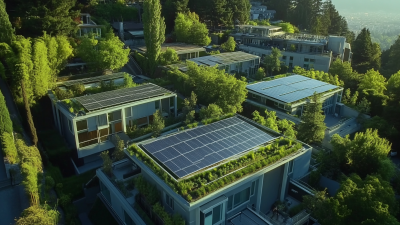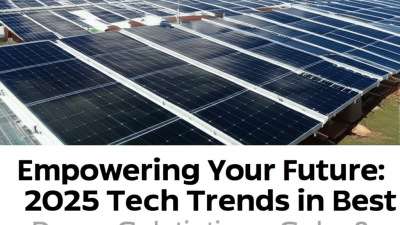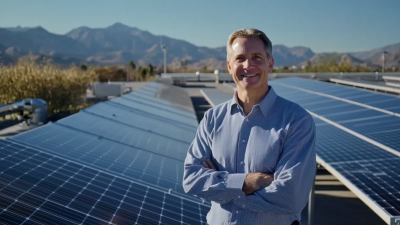Unlocking the Future: How Solar PV Panels Transform Home Energy Efficiency in 2023
As we step into 2023, the evolving landscape of renewable energy is more prominent than ever, with "Solar PV Panels" at the forefront of this transformation. These innovative technologies are not merely a trend; they are a crucial component in enhancing home energy efficiency and sustainability. With a growing emphasis on reducing carbon footprints and embracing cleaner energy alternatives, homeowners are increasingly turning towards solar solutions that harness the power of the sun. This article explores key insights and practical tips on how Solar PV Panels can revolutionize home energy systems, highlighting their economic benefits, environmental impact, and the ease of integration into everyday life. Discover how investing in solar technology not only serves personal and financial goals but also contributes to a larger movement towards energy independence and ecological responsibility. Join us as we unlock the future of solar energy and uncover the potential hidden within your home.

Understanding Solar PV Technology: Basics and Advancements in 2023
Solar photovoltaic (PV) technology has evolved significantly in 2023, offering enhanced efficiency and sustainability for homeowners. At its core, solar PV systems convert sunlight into electricity using semiconductor materials. The basic components of a solar PV system include solar panels, an inverter, and a mounting structure. These panels capture solar energy, which is then transformed into usable power, allowing homeowners to reduce their reliance on traditional energy sources. The advancements in materials and technology, such as the use of bifacial solar cells and improved energy storage solutions, have boosted conversion rates and durability, making solar energy more accessible and efficient.
In addition to technological advancements, 2023 has seen a significant increase in the integration of smart energy management systems with solar PV solutions. These systems optimize energy usage by storing excess power generated during peak sunlight hours and distributing it during periods of high demand or low production. This not only enhances energy savings but also contributes to a more resilient energy grid. Furthermore, as homeowners become more aware of their carbon footprint, the popularity of solar PV installations continues to grow, underscoring the shift towards renewable energy sources and the importance of sustainability in home energy solutions.
Assessing Your Home's Energy Needs for Optimal Solar Panel Installation
Assessing your home's energy needs is crucial for optimal solar panel installation. In 2023, as energy prices continue to rise, the integration of solar photovoltaic (PV) panels can significantly enhance energy efficiency and reduce long-term electricity costs. According to the Solar Energy Industries Association (SEIA), the average residential solar panel system size in the U.S. is about 6 kilowatts (kW), which can save homeowners approximately $1,500 annually on energy bills. Understanding your energy consumption patterns, such as peak usage times and total monthly consumption, will enable you to determine the size and type of system that best fits your requirements.
To accurately evaluate your energy needs, homeowners should conduct an energy audit, assessing factors such as insulation quality, appliance efficiency, and lifestyle habits. The results can guide decisions on the number of panels needed and potential enhancements to energy efficiency before installation. Notably, the National Renewable Energy Laboratory (NREL) estimates that households can reduce their energy load by up to 30% through upgrades like energy-efficient appliances and smart home technologies. This strategic approach not only maximizes the benefits of solar PV systems but also contributes to a more sustainable energy future.
Unlocking the Future: How Solar PV Panels Transform Home Energy Efficiency in 2023
| Home Size (sq ft) | Average Monthly Energy Consumption (kWh) | Recommended Solar PV System Size (kW) | Estimated Annual Savings ($) | Payback Period (Years) |
|---|---|---|---|---|
| 1,500 | 800 | 5 | $960 | 4 |
| 2,000 | 1,100 | 7 | $1,320 | 5 |
| 2,500 | 1,400 | 9 | $1,680 | 6 |
| 3,000 | 1,600 | 11 | $1,920 | 7 |
Step-by-Step Guide to Choosing the Right Solar PV System for Your Home
 When considering a transition to solar energy, choosing the right solar PV system for your home is crucial. Start by assessing your energy needs. Analyze your monthly electricity bills to determine your average energy consumption. This will guide you in selecting a system size that meets your household requirements. Consider factors such as the orientation and shading of your roof, as these will affect the efficiency of the solar panels.
When considering a transition to solar energy, choosing the right solar PV system for your home is crucial. Start by assessing your energy needs. Analyze your monthly electricity bills to determine your average energy consumption. This will guide you in selecting a system size that meets your household requirements. Consider factors such as the orientation and shading of your roof, as these will affect the efficiency of the solar panels.
Tips: Look for panels with a high efficiency rating and a good warranty for long-term performance. Engage with reputable solar providers who offer comprehensive assessments to help you make informed decisions.
Next, consider your budget and the available financing options. Solar installations can be a significant investment; therefore, understanding the costs, available rebates, and incentives can improve your return on investment. Research loan programs or leasing options that can ease the upfront financial burden.
Tips: Check if your local government or utilities provide incentives for adopting solar energy. These can significantly lower your installation costs and enhance the overall value of the investment.
Maximizing Energy Efficiency: Integrating Solar PV with Smart Home Solutions
The integration of solar photovoltaic (PV) panels with smart home solutions in 2023 has revolutionized energy efficiency for homeowners. As the world shifts toward sustainable energy sources, combining solar technology with smart devices enables greater control over home energy usage. Homeowners can now monitor and optimize their energy consumption in real-time, adjusting the use of appliances and systems to align with peak solar generation times. This synergy not only reduces reliance on the grid but also minimizes energy wastage, effectively slashing electricity bills.
Smart home systems complement solar PV by utilizing advanced algorithms and machine learning to enhance energy management. These technologies can forecast energy production based on weather patterns and historical data, allowing homeowners to set smart consumption schedules for appliances like washing machines or electric vehicles. Moreover, integration with energy storage solutions provides the flexibility to store excess solar energy for later use, further enhancing energy independence. Together, solar PV and smart home technologies create a seamless ecosystem, empowering homeowners to achieve unprecedented levels of efficiency and sustainability in their domestic energy use.

Financing Options and Incentives for Solar PV Installation in 2023
In 2023, the shift towards solar photovoltaic (PV) systems is not just a trend but a financial opportunity. According to the Solar Energy Industries Association (SEIA), the U.S. solar market has experienced a significant growth rate, with solar installations projected to exceed 30 gigawatts (GW) this year alone. This surge is largely influenced by various financing options and incentives available to homeowners interested in adopting solar technology.
One common pathway to solar adoption is through federal and state tax credits. The Federal Investment Tax Credit (ITC) allows homeowners to deduct 30% of the installation costs from their federal taxes, making solar more accessible and affordable. Additionally, many states offer unique financing options, such as Property Assessed Clean Energy (PACE) programs, which allow homeowners to finance solar installations through their property taxes. These incentives collectively enable homeowners to improve energy efficiency while significantly reducing initial investment costs, making solar PV an increasingly attractive choice for sustainable home energy solutions.
Solar PV Installation Growth and Incentives in 2023
Related Posts
-

Navigating Global Standards for Power Solar Panels in Export and Import Markets
-

Exploring Innovative Solutions: How Pv Panels Transform Energy Efficiency Worldwide
-

Empowering Your Future: 2025 Tech Trends in Best Power Solutions Solar & Essential Checklist for Global Buyers
-

Advantages of Utilizing Solar Energy Solutions for Sustainable Procurement
-

Unlocking the Future of Renewable Energy with Innovative Power Solar Panels Solutions
-

Global Demand for Solar Solutions: China’s Innovative Manufacturing Sets New Quality Standards
